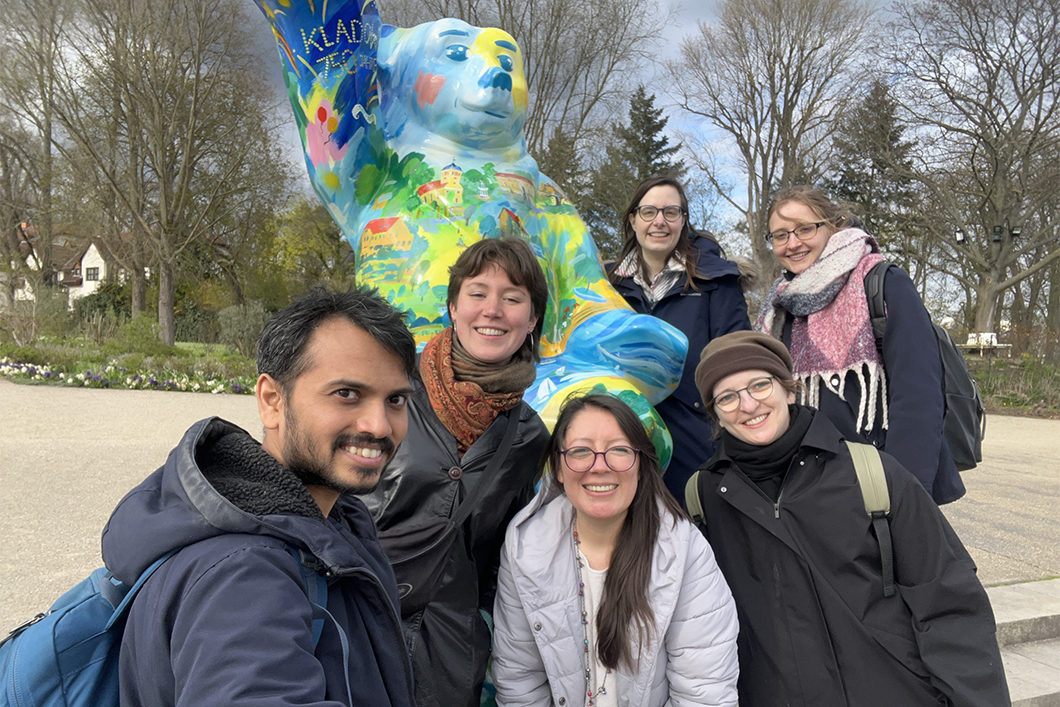
Source: Janine George
Many renewable energy applications require the development of tailored and improved materials. The research group led by Professor Janine George focuses on data analysis, machine learning and high-throughput calculations for the search and design of new materials, thus complementing the scientific portfolio of the Materials Chemistry department. In addition to her work as head of the junior research group, Janine George was appointed Professor of Materials Informatics at Friedrich Schiller University Jena in September 2023. Due to her outstanding performance, she was also honored in December 2023 as one of four young scientists of the Werner-von-Siemens-Ring Foundation. In 2024, Janine George received a Starting Grant of around 1.5 million euros from the European Research Council (ERC). The grant will support her research project ‘Multibonds’ and the work of the junior research group for five years. The group was originally founded as an internal BAM junior research group with associated funding.
Team
The group consists of experts in ab initio calculations, chemical bonding analysis and vibrational properties. Dr. George recently presented the group's research in a seminar as part of the Materials Project seminar series.
Research focus
New chemical heuristics
The group works to test and develop chemical heuristics (intuitive rules) to advance knowledge and understanding in solid-state chemistry and physics,1,2 using geometric and quantum chemical descriptors for chemical environments. For the latter, the group is developing open-source tools for automated bond analysis.3–5
High-throughput-calculations and automations
For the development of new chemical heuristics, it is necessary to have large amounts of reliably calculated material data. Here, the group develops workflows and methods for high-throughput calculations to reliably perform such calculations.3,5 Among other things, the group regularly contributes with its own developments to well-known open-source material informatics codes such as Pymatgen, Atomate or Atomate2 and has a lot of expertise with these codes.
Vibrational Properties
Vibration properties play a fundamental role in the stability and in heat transport of materials. Both material properties are particularly important for the safe use of materials. Here, the group is concerned with the ab initio prediction of such data in order to advance machine learning of such properties.6–8
Methods and workflows
The team is developing the following methods and workflows:
- Ab initio simulations for materials and molecules
- Ab initio calculation of vibrational properties of crystalline materials
- Material design for functional materials
- Workflow and automation development of ab initio calculations
- Development of geometric and quantum-chemical bonding-based material descriptors
- Data analysis and machine learning of material properties
Funding
The Junior research group led by Janine George ist being financed by BAM and a ERC Starting Grant funded by the European Union.
References
(1) George, J.; Waroquiers, D.; Di Stefano, D.; Petretto, G.; Rignanese, G.; Hautier, G. The Limited Predictive Power of the Pauling Rules. Angew. Chem. Int. Ed. 2020, 59 (19), 7569–7575.
https://onlinelibrary.wiley.com/doi/10.1002/anie.202000829.
(2) George, J.; Hautier, G. Chemist versus Machine: Traditional Knowledge versus Machine Learning Techniques. Trends Chem. 2021, 3 (2), 86–95.
https://doi.org/10.1016/j.trechm.2020.10.007.
(3) George, J. Automation in DFT-Based Computational Materials Science. Trends Chem. 2021, 3 (9), 697–699.
https://doi.org/10.1016/j.trechm.2021.07.001.
(4) LobsterPy. LobsterPY.
https://github.com/JaGeo/LobsterPy.
(5) George, J.; Petretto, G.; Naik, A.; Esters, M.; Jackson, A. J.; Nelson, R.; Dronskowski, R.; Rignanese, G.-M.; Hautier, G. Automated Bonding Analysis with Crystal Orbital Hamilton Populations. ChemPlusChem 2022, e202200123, DOI: 10.1002/cplu.202200123.
https://doi.org/10.1002/cplu.202200123.
(6) George, J.; Hautier, G.; Bartók, A. P.; Csányi, G.; Deringer, V. L. Combining Phonon Accuracy with High Transferability in Gaussian Approximation Potential Models. J. Chem. Phys. 2020, 153 (4), 044104.
https://doi.org/10.1063/5.0013826.
(7) Hanus, R.; George, J.; Wood, M.; Bonkowski, A.; Cheng, Y.; Abernathy, D. L.; Manley, M. E.; Hautier, G.; Snyder, G. J.; Hermann, R. P. Uncovering Design Principles for Amorphous-like Heat Conduction Using Two-Channel Lattice Dynamics. Materials Today Physics 2021, 100344.
https://doi.org/10.1016/j.mtphys.2021.100344.
(8) Bernges, T.; Hanus, R.; Wankmiller, B.; Imasato, K.; Lin, S.; Ghidiu, M.; Gerlitz, M.; Peterlechner, M.; Graham, S.; Hautier, G.; Pei, Y.; Hansen, M. R.; Wilde, G.; Snyder, G. J.; George, J.; Agne, M. T.; Zeier, W. G. Considering the Role of Ion Transport in Diffuson-Dominated Thermal Conductivity. Advanced Energy Materials 2022, 12, 2200717.
https://doi.org/10.1002/aenm.202200717.

Source: ERC
Project MultiBonds (grant agreement Nº 101161771) is being supported by an ERC Starting Grant, funded by the European Union. Views and opinions expressed are however those of the author(s) only and do not necessarily reflect those of the European Union or the European Research Council Executive Agency. Neither the European Union nor the granting authority can be held responsible for them.


